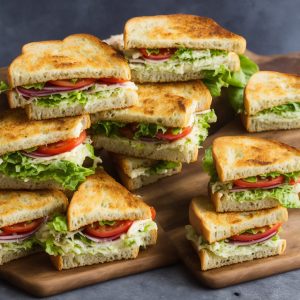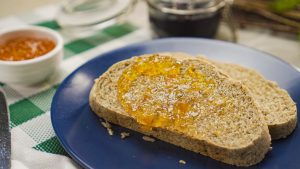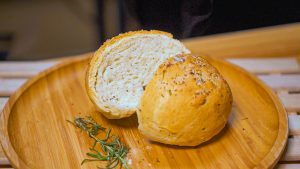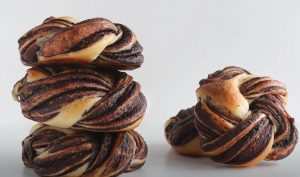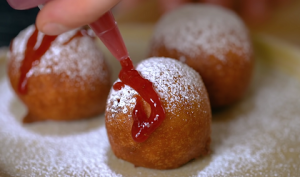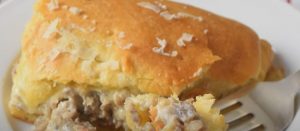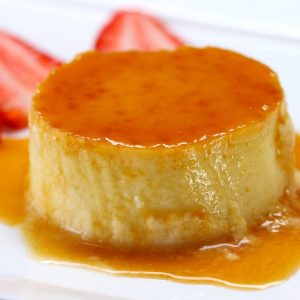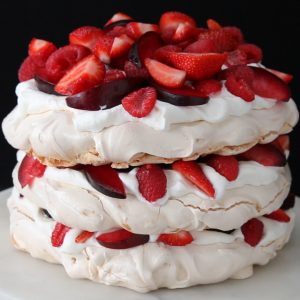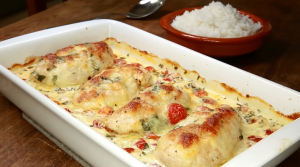Embarking on a homemade bread journey can be exciting and rewarding, especially when the result is a fragrant, delicious rosemary focaccia. This Italian bread, infused with fresh rosemary and sea salt, is perfect for dipping in soups or serving alongside any meal. The process is straightforward, making it an excellent choice for novice bakers.
The key ingredients for this recipe are active-dry yeast and fresh rosemary. Active-dry yeast is a common leavening agent in bread making and can be found in the baking aisle of your local supermarket. Fresh rosemary is a fragrant herb that adds a distinctive flavor to the focaccia. It can usually be found in the fresh produce section of your supermarket. Make sure to purchase a fresh sprig for the best flavor.
Key Ingredients for Rosemary Focaccia Bread
Warm water: This is used to activate the yeast. The water should be warm, but not hot, to promote yeast growth.
Sugar: Sugar provides food for the yeast, helping it to become active.
Active-dry yeast: A leavening agent that is responsible for making the focaccia rise and become fluffy.
All-purpose flour: The base of the focaccia dough. It creates the structure of the bread.
Extra virgin olive oil: Adds a rich flavor to the dough and gives the crust a golden color.
Flaky sea salt: Used for seasoning the bread. It also adds a nice crunch to the top of the focaccia.
Fresh rosemary: A fragrant herb that infuses the bread with a delightful, earthy flavor.
One reader, Jyoti Swan says:





This rosemary focaccia bread recipe is a game-changer! The bread turned out fluffy and flavorful, and the aroma of rosemary was heavenly. The recipe was easy to follow, and the end result was a hit with my family. I'll definitely be making this again!
Techniques for Making the Perfect Rosemary Focaccia Bread
How to activate yeast: Yeast needs to be activated in warm water with sugar. Let it sit for 5-10 minutes until it becomes foamy.
How to knead dough: After adding flour, olive oil, and salt, knead the dough in a stand mixer for 5 minutes until it becomes smooth and elastic.
How to let dough rise: After shaping the dough into a ball, place it in a greased bowl, cover it with a damp towel, and let it rise in a warm location for 45-60 minutes until it doubles in size.
How to shape the dough: Roll out the dough into a large circle or rectangle until it's about ½-inch thick, then let it continue to rise for another 20 minutes.
How to bake focaccia: Preheat the oven to 400°F, transfer the dough to a parchment-covered baking sheet, poke deep dents all over the surface, drizzle with olive oil, and sprinkle with rosemary and sea salt. Bake for 20 minutes until slightly golden and cooked through.
How to serve: Once baked, drizzle the focaccia with a little more olive oil if desired, then slice and serve warm.
How To Make Rosemary Focaccia Bread
Focaccia bread is a simple bread that any beginner can make. Yet, it’s loaded with lots of flavor. This recipe has olive oil, rosemary, & sea salt toppings.
Serves:
Ingredients
- 1⅓cupwarm water,(about 110 degrees F)
- 2tspsugar,or honey
- ¼ozactive-dry yeast,(1 pkg)
- 3½cupsall purpose flour
- ¼cupextra virgin olive oil,plus more for drizzling
- 2tspflaky sea salt,plus extra for sprinkling
- 2sprigsfresh rosemary
Instructions
-
Add warm water and sugar to the bowl of a stand mixer with the dough attachment, and stir to combine. Sprinkle the yeast on top of the water. Give the yeast a quick stir to mix it in with the water. Then let it sit for 5 to 10 minutes until the yeast is foamy.
-
Set the mixer to low speed, and gradually add flour, olive oil and salt. Increase speed to medium-low, and continue mixing the dough for 5 minutes. If the dough is too sticky and isn’t pulling away from the sides of the bowl, add in an extra ¼ cup flour while it is mixing.
-
Remove dough from the mixing bowl, and shape it into a ball. Grease the mixing bowl (or a separate bowl) with olive oil or cooking spray, then place the dough ball back in the bowl and cover it with a damp towel. Place in a warm location and let the dough rise for 45 to 60 minutes, or until it has nearly doubled in size.
-
Turn the dough onto a floured surface, and roll it out into a large circle or rectangle until that the dough is about ½-inch thick. Cover the dough again with the damp towel, and let the dough continue to rise for another 20 minutes.
-
Preheat oven to 400 degrees F. Transfer the dough to a large parchment-covered baking sheet (or press it into a 9 x 13-inch baking dish). Use fingers to poke deep dents all over the surface of the dough.
-
Drizzle a tablespoon or two of olive oil evenly all over the top of the dough, and sprinkle evenly with the fresh rosemary needles and sea salt.
-
Bake for 20 minutes, or until the dough is slightly golden and cooked through.
-
Remove from the oven, and drizzle with a little more olive oil if desired. Slice, and serve warm.
Nutrition
- Calories: 178.21kcal
- Fat: 4.95g
- Saturated Fat: 0.71g
- Monounsaturated Fat: 3.35g
- Polyunsaturated Fat: 0.63g
- Carbohydrates: 28.94g
- Fiber: 1.26g
- Sugar: 0.80g
- Protein: 4.03g
- Sodium: 161.42mg
- Calcium: 9.23mg
- Potassium: 50.31mg
- Iron: 1.79mg
- Vitamin A: 1.22µg
- Vitamin C: 0.18mg
Crucial Technique Tip for Making Rosemary Focaccia Bread
When making your rosemary focaccia bread, it's crucial to give the dough ample time to rise. This process, known as proofing, allows the yeast to ferment the dough, creating gas bubbles that result in a light, airy bread. If your kitchen is particularly cold, you can create a warm environment for your dough by turning your oven on to the lowest setting, then turning it off and placing the covered dough inside. This will speed up the rising process. Additionally, don't skip the step of poking holes in the dough before baking. This traditional focaccia technique helps to create its characteristic dimpled surface, and allows the olive oil and toppings to permeate the bread, enhancing its flavor.
Time-Saving Tips for Making Focaccia Bread
Prep ahead: Mix the dough the night before and let it rise in the fridge overnight. This will save time on the day of baking.
Use a stand mixer: Let the machine do the kneading work for you, saving time and effort.
Double batch: Make two loaves and freeze one for later. This way, you'll have homemade focaccia ready to go whenever you need it.
Pre-slice: Cut the rosemary and measure out the ingredients in advance to streamline the process.
Bake in advance: Bake the focaccia a day ahead and reheat it just before serving to save time on the day of your meal.
Substitute Ingredients For Rosemary Focaccia Bread Recipe
warm water - Substitute with milk: Milk can add richness and tenderness to the bread, resulting in a softer texture and slightly sweeter flavor.
active-dry yeast - Substitute with instant yeast: Instant yeast can be added directly to the dry ingredients without needing to be activated in warm water, saving time in the bread-making process.
all purpose flour - Substitute with bread flour: Bread flour has a higher protein content, which can result in a chewier and more structured focaccia bread.
extra virgin olive oil - Substitute with grapeseed oil: Grapeseed oil has a neutral flavor and a high smoke point, making it a suitable substitute for baking and providing a lighter taste compared to olive oil.
flaky sea salt - Substitute with kosher salt: Kosher salt has a similar flaky texture and less intense saltiness, making it a suitable substitute for flaky sea salt in the focaccia bread recipe.
fresh rosemary - Substitute with dried rosemary: Dried rosemary can be used as a substitute, but in smaller quantities, as its flavor is more concentrated than fresh rosemary.
Presenting Your Homemade Focaccia Bread
Elevate the dough: Gently shape the dough into a perfectly round shape, ensuring it is evenly thick and smooth on the surface. This will create a visually appealing base for the focaccia.
Artistic olive oil drizzle: Drizzle the olive oil in a deliberate and artistic manner, ensuring it enhances the appearance of the focaccia without overwhelming it.
Sprinkle with sea salt: Carefully sprinkle the flaky sea salt over the focaccia, ensuring it is evenly distributed and adds a touch of visual interest.
Garnish with fresh rosemary: Place the fresh rosemary sprigs strategically on the focaccia, adding a pop of color and a delightful aroma to the presentation.
Precise slicing: When slicing the focaccia, ensure each piece is cut with precision and presented neatly on the serving platter, showcasing the beautiful texture of the bread.
Elevate the serving platter: Choose a sophisticated serving platter that complements the colors of the focaccia and enhances the overall presentation.
Accompany with complementary ingredients: Consider serving the focaccia with complementary ingredients such as flavored olive oils, balsamic reduction, or a selection of artisanal cheeses to elevate the overall culinary experience.
Essential Tools for Making Focaccia Bread at Home
- Stand mixer: A stand mixer is a versatile tool that can be used for mixing and kneading dough, making it ideal for preparing the focaccia bread dough.
- Dough attachment: The dough attachment for the stand mixer is specifically designed for kneading and mixing bread dough, ensuring a consistent and well-developed texture.
- Baking sheet: A baking sheet is essential for baking the focaccia bread in the oven, providing a flat and even surface for the dough.
- Parchment paper: Parchment paper is used to line the baking sheet, preventing the focaccia bread from sticking and making cleanup easier.
- Rolling pin: A rolling pin is used to roll out the dough to the desired thickness, ensuring an even and uniform shape for the focaccia bread.
- Olive oil: Olive oil is a key ingredient for both the dough and for drizzling over the top of the focaccia bread before baking, adding flavor and moisture.
- Baking dish: A baking dish can be used as an alternative to a baking sheet for shaping and baking the focaccia bread, providing a contained space for the dough to rise and bake.
- Paring knife: A paring knife can be used to strip the rosemary needles from the sprigs, allowing them to be evenly distributed over the focaccia bread before baking.
Storing and Freezing Homemade Focaccia Bread
Once the focaccia bread has cooled completely, wrap it tightly in plastic wrap or aluminum foil to prevent it from drying out. Store the wrapped bread at room temperature for up to 2-3 days.
If you want to keep the focaccia fresh for a longer period, you can store it in an airtight container or resealable plastic bag. This will help maintain its moisture and prevent it from absorbing any odors from other foods in your kitchen.
For longer storage, you can freeze the focaccia bread. Wrap the cooled bread tightly in plastic wrap, then place it in a freezer-safe bag or container. Label the bag or container with the date and store it in the freezer for up to 1 month.
To thaw the frozen focaccia, remove it from the freezer and let it thaw at room temperature for about 2-3 hours. You can also thaw it in the refrigerator overnight if you prefer.
To reheat the focaccia bread, wrap it in aluminum foil and place it in a preheated 350°F (175°C) oven for about 10-15 minutes, or until it's heated through and crispy on the outside. Alternatively, you can slice the bread and toast it in a toaster or under the broiler for a few minutes.
If you find that the focaccia has lost some of its moisture after storing or freezing, you can brush it lightly with some olive oil before reheating to help restore its texture and flavor.
How To Reheat Leftover Focaccia Bread
Preheat your oven to 350°F (175°C). Wrap the leftover focaccia in aluminum foil and place it on a baking sheet. Heat the bread in the oven for about 10-15 minutes, or until it's heated through and the crust is crispy again. This method helps to restore the bread's texture and freshness, making it taste almost like it did when it was first baked.
If you're short on time, you can also reheat the focaccia in the microwave. Place the bread on a microwave-safe plate and heat it on high power for 15-20 seconds. If it's not warm enough, continue heating it in 10-second intervals until it reaches your desired temperature. Keep in mind that microwaving the bread may result in a slightly softer crust compared to oven reheating.
For a crispy crust and a soft interior, try reheating the focaccia in a skillet on the stovetop. Heat a tablespoon of olive oil in a large skillet over medium heat. Place the bread in the skillet and cook for 2-3 minutes on each side, or until it's heated through and the crust is crispy. This method adds a nice crunch to the bread and infuses it with extra flavor from the olive oil.
If you have a toaster oven, you can use it to reheat smaller pieces of focaccia. Cut the bread into slices and place them in the toaster oven. Heat the slices at 350°F (175°C) for 5-7 minutes, or until they're warmed through and slightly crispy on the outside. This method is quick and convenient, especially if you're only reheating a small amount of bread.
For a unique twist, try grilling your leftover focaccia. Preheat your grill to medium heat and brush both sides of the bread with olive oil. Place the bread on the grill and cook for 2-3 minutes on each side, or until it's heated through and has nice grill marks. The smoky flavor from the grill adds a new dimension to the bread's taste, making it perfect for serving alongside grilled meats or vegetables.
Interesting Fact About Focaccia Bread
Focaccia bread is believed to have originated in ancient Rome and is one of the oldest types of bread in Italy. It was traditionally made with a mix of flour, water, and olive oil, and often flavored with herbs like rosemary or thyme.
Is Making Focaccia Bread at Home Cost-Effective?
This rosemary focaccia bread recipe is highly cost-effective for a household. The main ingredients, such as flour, yeast, and olive oil, are affordable and commonly found in most kitchens. The addition of fresh rosemary may require a small investment, but it elevates the flavor and aroma of the bread. Overall, this recipe is budget-friendly and offers a delightful homemade bread experience. Rating: 9/10. Approximate cost for a household of 4 people: $5-7 USD.
Is Rosemary Focaccia Bread Healthy or Unhealthy?
The rosemary focaccia bread recipe is relatively healthy compared to other bread recipes, as it uses simple ingredients like flour, yeast, olive oil, and fresh rosemary. However, there are a few aspects that could be improved to make it even healthier:
- The recipe calls for all-purpose flour, which is refined and lacks fiber and nutrients. Swapping some or all of the all-purpose flour with whole wheat flour would increase the bread's nutritional value.
- The recipe uses a significant amount of olive oil, which is a healthy fat but still high in calories. Reducing the amount of olive oil could lower the overall calorie content.
- The recipe includes added sugar, which is not necessary for the bread's flavor or texture. Omitting the sugar would make the bread slightly healthier.
To make this recipe even healthier, consider the following suggestions:
- Replace half or all of the all-purpose flour with whole wheat flour, which is higher in fiber, vitamins, and minerals.
- Reduce the amount of olive oil used in the dough and for drizzling on top. You can still achieve a flavorful bread with less oil.
- Omit the sugar entirely, as the yeast will still activate and the bread will rise without it.
- Add other healthy toppings like sliced olives, sun-dried tomatoes, or roasted garlic to increase the bread's flavor and nutritional value.
- Serve the focaccia with a side of vegetables or a salad to balance out the meal and add more nutrients.
Editor's Opinion on This Rosemary Focaccia Bread Recipe
The rosemary focaccia bread recipe you provided is a classic and delightful choice. The combination of warm water, olive oil, and fresh rosemary creates a flavorful and aromatic bread that is perfect for any occasion. The instructions are clear and easy to follow, making it accessible for both novice and experienced bakers. The addition of flaky sea salt adds a wonderful texture and depth of flavor to the bread. Overall, this recipe is a winner and is sure to impress anyone who tries it.
Enhance Your Rosemary Focaccia Bread Recipe with These Unique Side Dishes:
Similar Bread Recipes to Try
Perfect Main Courses and Desserts to Pair with Rosemary Focaccia Bread
Why trust this Rosemary Focaccia Bread Recipe:
This #food# recipe guarantees success, as it has been meticulously crafted to ensure a delightful outcome. The use of active-dry yeast and warm water activates the dough, resulting in a perfect rise. The addition of extra virgin olive oil infuses the bread with a rich flavor, while the fresh rosemary adds a delightful aroma. The step-by-step instructions are easy to follow, making it accessible for all home cooks. Trust in the quality of the ingredients and the expertise behind this #food# creation.
Was this page helpful?
Have your own special recipe to share? Submit Your Recipe Today!




